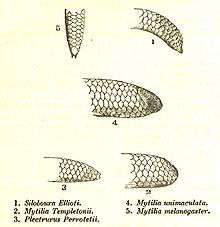Uropeltidae
| Uropeltidae | |
|---|---|
 | |
| Ceylon earth snake, Uropeltis ceylanica | |
| Scientific classification | |
| Kingdom: | Animalia |
| Phylum: | Chordata |
| Subphylum: | Vertebrata |
| Class: | Reptilia |
| Order: | Squamata |
| Suborder: | Serpentes |
| Infraorder: | Alethinophidia |
| Family: | Uropeltidae J.P. Müller, 1832 |
| Synonyms | |
| |
- Common names: pipe snakes, shield-tailed snakes.[2]
The Uropeltidae are a family of primitive burrowing snakes endemic to southern India and Sri Lanka. The name is derived from the Greek words ura ("tail") and pelte ("shield"), indicating the presence of the large keratinous shield at the tip of the tail. Currently, eight genera are recognized comprising 47 species.[2] These snakes are not venomous.[3]
Description

These are small snakes, with adults growing to between 20 and 75 cm in length. They are adapted to a fossorial way of life, which is apparent in their anatomy. The skull is primitive and inflexible, with a short vertical quadrate bone and rigid jaws; the coronoid bone is still present in the lower jaw. The orbital bones are absent, the supratemporal is vestigial and the eyes are small and degenerate, not covered by a brille, but by large polygonal shields. However, the pelvis and hind limbs, the presence of which is also considered a primitive trait, have disappeared in this family.[4]
The tail is characteristic, ending in either A) an enlarged rigid scale with two points, or more often an upper surface with a subcircular area covered with thickened spiny scales, or B) a much enlarged spiny plate. The ventral scales are much reduced in size.[4] The body is cylindrical and covered with smooth scales.
Geographic range
They are found in southern India and Sri Lanka.[1] In India, their distribution is mainly along the hills of Western Ghats, and only one species, Elliot's shieldtail, Uropeltis ellioti, has been reported from other areas such as Eastern Ghats and hills of Central India. In Sri Lanka, they occur in areas whose climatic conditions are similar to that of Western Ghats, like the south western part of Sri Lanka.
Feeding
Their diets consist mostly of invertebrates, particularly earth worms, although few studies have verified this.
Reproduction
All members of this family retain eggs that hatch within the body of the mother (ovoviviparous).[5]
Genera
| Genus[2] | Taxon author[2] | Species[2] | Common name | Geographic range[1] |
|---|---|---|---|---|
| Brachyophidium | Wall, 1921 | 1 | Southern India in the Palni Hills | |
| Melanophidium | Günther, 1864 | 3 | Southern India in the Peermade Hills in Kerala and the Anaimalai Hills in Tamil Nadu | |
| Platyplectrurus | Günther, 1868 | 2 | Southern India and Sri Lanka | |
| Plectrurus | A.H.A. Duméril, 1851 | 4 | Southern India. | |
| Pseudotyphlops | Schlegel, 1839 | 1 | Sri Lanka in central and southern Uva and Sabaragamuwa Provinces | |
| Rhinophis | Hemprich, 1820 | 12 | Southern India and Sri Lanka | |
| Teretrurus | Beddome, 1886 | 1 | Southern India in Wayanad, Travancore, Nalumukku, Oothu, the Manimuthar Hills (in the Western Ghats of Tirunelveli) and Nyamakad (in the Western Ghats of the Kerala Munnar Hills) | |
| UropeltisT | Cuvier, 1829 | 26 | Southern India and Sri Lanka | |
See also
- List of uropeltid species and subspecies
- Uropeltidae by common name
- Uropeltidae by taxonomic synonyms
- List of snakes, overview of all snake families and genera.
References
- 1 2 3 4 McDiarmid RW, Campbell JA, Touré T. 1999. Snake Species of the World: A Taxonomic and Geographic Reference, vol. 1. Herpetologists' League. 511 pp. ISBN 1-893777-00-6 (series). ISBN 1-893777-01-4 (volume).
- 1 2 3 4 5 "Uropeltidae". Integrated Taxonomic Information System. Retrieved 17 August 2007.
- ↑ Greene, H. W. and R. W. Mcdiarmid. 2005. Wallace and Savage: heroes, theories, and venomous snake mimicry. pp 190–208. Donnelly M. A., Crother B. I., Guyer C., Wake M. H., White M. E. (eds.). Ecology and Evolution in the Tropics, a Herpetological Perspective. Chicago University of Chicago Press.
- 1 2 Parker HW, Grandison AGC. 1977. Snakes -- a natural history. Second Edition. British Museum (Natural History) and Cornell University Press. 108 pp. 16 plates. LCCCN 76-54625. ISBN 0-8014-1095-9 (cloth), ISBN 0-8014-9164-9 (paper).
- ↑ Tinkle, D.W., Gibbons, J.W. (1977). The Distribution and Evolution of Viviparity in Reptiles. University of Michigan Museum of Zoology, Miscellaneous Publications 154. PDF
Further reading
- Das I. 2002. A Photographic Guide to Snakes and Other Reptiles of India. Sanibel Island, Florida: Ralph Curtis Books. 144 pp. ISBN 0-88359-056-5. (Uropeltidae, p. 59).
External links
| Wikimedia Commons has media related to Uropeltidae. |
- Uropeltidae at the Reptarium.cz Reptile Database. Accessed 3 November 2008.
Two references to Shieldtail sightings in Bangalore, India in October 2010 and November 2013:
http://deponti.livejournal.com/1033285.html